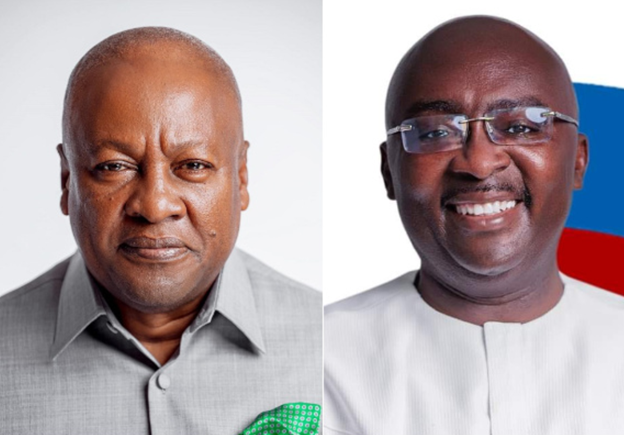As Ghana approaches the December 7 general elections, there is rising political tension amid calls for a peaceful atmosphere.
Citizens are gearing up to exercise their democratic rights, while presidential candidates are, as expected, making their final appeals for votes.
Nonetheless, Thursday, December 5, will mark the end of campaign activities, with the NDC and NPP holding their final rallies before polling day.
However, beyond the rallies and promises, voting patterns from past elections provide vital insights into what each party needs to secure to win. NDC and NPP have made claims, setting percentage targets of votes that should get them to win.
This analysis by DUBAWA delves into historical voting trends in the Volta, Oti, and Ashanti Regions to answer a critical question: What percentage of votes does the NDC need in Volta and Ashanti to win over the NPP?
Volta and Oti Region Voting Patterns (1992-2020)
The Volta Region has been the NDC’s strongest fortress since 1992.
Below is a detailed breakdown of the party’s performance against the NPP over the years:
Volta Region Historical Data

Oti Region Performance
Before 2018, the Oti Region was part of Volta. It officially became a separate entity following a referendum, with its capital being Dambai. Here’s how NDC and NPP have performed in Oti since 2016:
Ashanti Region Voting Patterns (1992-2020)
The Ashanti Region has consistently been the NPP’s stronghold.
Below is a summary of the party’s dominance over the years:

Key insights from DUBAWA
NDC in Volta and Oti Regions
The NDC’s dominance in Volta remains critical. Any significant reduction below 80% could jeopardise their chances in 2024, especially as Oti remains a more competitive landscape for the NPP.
In Oti, the NPP’s growing vote share (35% in 2020) indicates the need for the NDC to intensify campaigns to maintain at least 60% of the vote.
Critical questions tackled by DUBAWA based on historical voting patterns in Ashanti and Volta Regions, including Oti, from 1992 to 2020:
What percentage does the NDC require in Volta?
The NDC needs to secure at least 80% of the votes in the Volta Region to maintain its dominance in 2024. This level of support is critical to offset NPP’s strength in Ashanti and swing regions.
What percentage does the NDC require in Oti?
Given the NPP’s steady rise in the Oti Region, the NDC must achieve at least 60% of the votes. Falling below this threshold could weaken the NDC’s overall chances in the 2024 national election.
What percentage does the NDC require in Ashanti?
The Ashanti Region has been challenging for the NDC due to NPP’s rooted dominance. However, to make a significant impact, the NDC must aim for at least 30% to 35% of the votes in Ashanti.
In 1996, when the NDC came close to this range with 33.8%, they won the national election.
However, in 2016 and 2020, the NDC’s vote share in Ashanti dropped below 30%, correlating with losses in the national polls.
A performance above 30% in Ashanti would demonstrate increased support and be crucial in neutralising NPP’s numerical advantage in 2024.
Does winning 75% of Ashanti guarantee NPP victory?
No. While a strong performance in Ashanti is vital for the NPP, their national victory depends on strong results in swing regions, particularly Greater Accra, Central, and Western.
Swing Regions Matter
Both parties must perform well in swing regions like Greater Accra, Central, and Western to secure a national win. For instance, the NPP secured over 74% in Ashanti in 2008 but lost the national election due to weaker outcomes in Greater Accra and Central Regions.
Conclusion
While Volta and Ashanti Regions remain key battlegrounds for NDC and NPP, neither stronghold guarantees victory.
The outcome of the December 7 elections will ultimately be determined by how well each party performs in swing regions.
Both political parties must strategically target Greater Accra, Central, and Western to secure the presidency.
Source: ghana.dubawa.org


